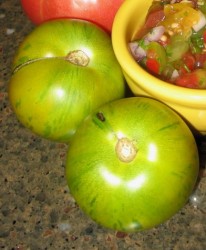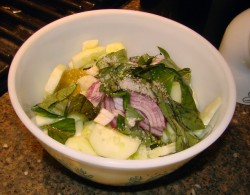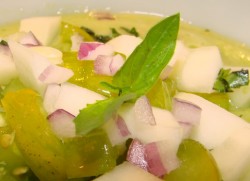How Green Was My Gazpacho
Heirloom tomatoes offer an amazing array of colors, shapes and flavors to tempt the palate and the imagination of the cook.
It is great fun to use them in classic recipes to bring a new twist to old favorites. My best beloved heirloom tomatoes are the lovely little Green Zebras. They are about the size of a plum, with chartreuse to yellow skin striped with deep green and kiwi-colored flesh. Their flavor is a good balance of sweet and tart, with a tangy finish that goes beautifully in salsas or with goat cheese in salads. I also like them as a topping on open-faced toasted cheese sandwiches along with basil and pine nuts, but in August, the last thing I want to do is fire up my broiler in order to make lunch.
Gazpacho is a staple recipe in my summer kitchen; this Spanish cold soup is perfect for the sweltering days of August when onions, garlic, tomatoes and cucumbers are in wild abundance, and appetites are on the wane because of the hellish heat. Thanks to modern technology, gazpacho a quick way to use up the bounty from the garden and farmer’s market without lighting a burner on the stove or breaking into a sweat.
There seem to be two ways to eat your gazpacho: blended or chunky. Folks who favor the blended sort of gazpacho like their chilled soup to be smooth, with all the vegetables pureed into a thick, red silken bowl of comfort. This method of preparing the soup forces all of the ingredients marry together into a harmonious whole that is unbroken by individual flavors.
The folks who like their gazpacho chunky, however, want to see the different colors, and experience the different flavors in quick bursts under their teeth. The truth is that even chunky gazpacho has some pureed component to make the dish somewhat sloshy; otherwise one would be eating a salad, not a soup. But aficionados of the chunky gazpacho tend to put as little puree in their soups as is physically possible while still making a soup.
As for me, I fall in the middle. I like the smooth cool puree that goes so soothingly down the throat, but also like a little bit of texture to set my teeth into. So, I make my gazpacho by pureeing 2/3 of my ingredients, and then taking the final third, and dicing or mincing them finely, to be mixed into the frothy puree. An immersion blender makes quick work of this process; all I have to do is roughly chop my tomatoes–I leave the skins on because I like having the fiber in my diet, and because the tiny flecks of yellow and darker green look pretty in the puree–cucumbers, onions, garlic and chile peppers (I was fresh out of sweet peppers–bad me), and then let the blender do the rest. After I add extra virgin olive oil, a dash of white wine vinegar, and a pinch of salt to the bowl, it only takes a few passes with the “magic wand” of the stick blender to take care of this stage of the process.
Within a few seconds, the vegetables are reduced to a frothy, thick liquid the color of a very fresh Haas avocado, with tiny flecks of deep green, yellow and violet from the tomato skins and red onion. The olive oil gives the mixture of delicious velvety quality that is hard to replicate any other way; bread-thickened gazpacho is good, but not as silky as one with a good amount of olive oil in it. (I actually thought of using some avocado to take the place of some of the olive oil, but I wasn’t certain how that would change the taste of the gazpacho. I may try it next week if I can get more Green Zebras at the market this weekend.)
Then, I just carefully dice the other third of the tomatoes, cucumbers and onions finely, and add some minced lemon basil, which is an innovation for the dish this year.It adds a sparkling basil flavor enhanced by a definite citrus tang. I mix them together, leaving a handful of the chopped bits to garnish the top of the soup, and voila! A beautiful cold soup is born: a healthy, light meal or snack to help nourish a wilting body on a sunbaked day.
The green color, punctuated by bits of yellow from the tomato skin, the white of cucumber, and the violet of red onion, is to me more cooling than the traditional red. The colors, in fact, brought to mind the delicate colors of jade: celedon green flecked with emerald and peridot shades, cloud-white and delicate orchid.
The Green Zebras also lent their tang to the soup; I didn’t use as much vinegar in it as I have in past years, in large part because of the acidic tang of the tomatoes, and also because I wanted the lemon basil to take a starring role in the flavor profile of the soup.
It was definitely an experiment which paid off, and I am proud to say that with the exception of the olive oil and vinegar, all of the ingredients for this dish were grown within ten miles of my home: some (the chile and lemon balm) as close as my deck.
When you read the recipe, you will note that some of my measurements are approximate. That is because much of gazpacho making is the art of working “to taste.” Some people like it more sour, others like it sweeter. Some like more of the herbal flavor, while others favor the peppers and cucumbers. Others want nothing to step in front of the voluptuous kiss of the tomatoes.
Just look at this recipe as a guideline and create your own gazpacho of a different color.
Jade Zebra Gazpacho
Ingredients:
6 Green Zebra tomatoes–four very ripe and two just ripe
1 fresh garlic clove, peeled and sliced
1 medium size cucumber, peeled and cut into thirds
1 small red onion, peeled and cut into thirds
1 small green chile (or one small green sweet pepper) cut into thirds
1/8 -1/4 cup extra virgin olive oil
1/2 teaspoon salt or to taste
1/2 tablespoon white wine or sherry vinegar (or to taste)
3 tablespoons roughly chopped fresh lemon basil
tiny lemon basil leaves to garnish
Method:
Roughly cut up the four very ripe tomatoes without peeling them and put them into a deep bowl. Add the garlic and two thirds of the cucumber and onion, both roughly chopped. Roughly chop two thirds of the chile or sweet pepper, and add it to the bowl, along with the olive oil, salt, white wine vinegar and two tablespoons of the basil.
Using an immersion blender, puree the ingredients until a thick, frothy liquid forms.
Carefully seed the remaining third of the cucumber, and carefully cut the remaining tomatoes, cucumber, and onion into a very fine dice. Mince the remaining bit of chile and the basil leaves, and then mix all of these vegetables together. Leave a few tablespoons of these chopped vegetables aside as garnish, and stir the rest of them into the soup. Cover and chill the soup and garnishes.
Before serving, sprinkle garnishes, including whole lemon basil leaves, over the top of the soup, and serve in small cups or bowls as an exquisite appetizer or spoon it into larger bowls for a light lunch.
5 Comments
RSS feed for comments on this post.
Sorry, the comment form is closed at this time.
Powered by WordPress. Graphics by Zak Kramer.
Design update by Daniel Trout.
Entries and comments feeds.








[…] continue article at Barbara delivered by conSALSITA […]
Pingback by How Green Was My Gazpacho — August 31, 2007 #
ooh… that colour is GORGEOUS! so summery! Next year I’m going to try growing at least one heirloom tomato. Wish me luck – I’m known as a serial killer of plants even though I try SO hard to be a nurturer 🙂
Comment by shammi — August 31, 2007 #
looks so delicious.. i am the smooth puree person and my husband loves the chunky one, so i think i will make ur style…killing two birds with one stone eh!
Comment by rajitha — August 31, 2007 #
Thanks you for this wonderful relief reading. This post has really relaxed me after the earache from Pim’s incessant ranting about gastronomic purism. Your gazpacho reads and looks simply beautiful, and may I add that I always feel that I can just sit back and read what you have to say in a tranquil mood, and learn something from you. You’re definitely right about not adding the avocado, because I think that would spoil the other flavours. I’m no purist by a long shot, but I really respect your judgement when adapting classics like this. Thanks again.
Comment by Trig — August 31, 2007 #
Another lover of the Green Zebras here. We grow about two dozen tomato varieties, and, like you, count the little zebras amongst our favorites. This morning we had them sliced alongside eggs scrambled with sauteed onions and smoked salmon — all on a pale green pottery plate. Treat for the eyes as well as the tastebuds.
Comment by Casey — September 2, 2007 #